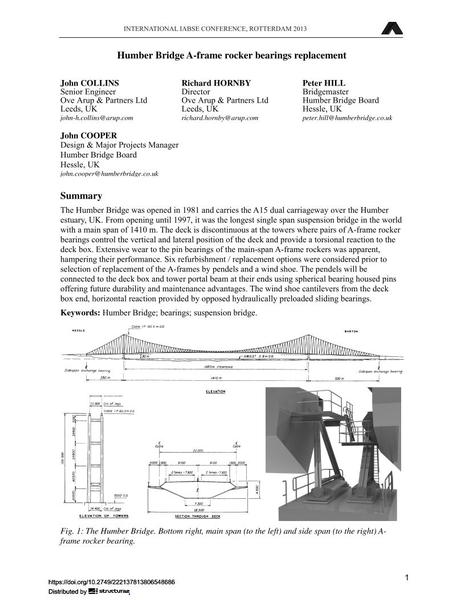Humber Bridge A-frame rocker bearings replacement

|
|
|||||||||||
Détails bibliographiques
| Auteur(s): |
John Collins
Richard Hornby Peter Hill John Cooper |
||||
|---|---|---|---|---|---|
| Médium: | papier de conférence | ||||
| Langue(s): | anglais | ||||
| Conférence: | IABSE Conference: Assessment, Upgrading and Refurbishment of Infrastructures, Rotterdam, The Netherlands, 6-8 May 2013 | ||||
| Publié dans: | IABSE Conference, Rotterdam, May 2013 | ||||
|
|||||
| Page(s): | 638-639 | ||||
| Nombre total de pages (du PDF): | 8 | ||||
| Année: | 2013 | ||||
| DOI: | 10.2749/222137813806548686 | ||||
| Abstrait: |
The Humber Bridge was opened in 1981 and carries the A15 dual carriageway over the Humber estuary, UK. From opening until 1997, it was the longest single span suspension bridge in the world with a main span of 1410 m. The deck is discontinuous at the towers where pairs of A-frame rocker bearings control the vertical and lateral position of the deck and provide a torsional reaction to the deck box. Extensive wear to the pin bearings of the main-span A-frame rockers was apparent, hampering their performance. Six refurbishment / replacement options were considered prior to selection of replacement of the A-frames by pendels and a wind shoe. The pendels will be connected to the deck box and tower portal beam at their ends using spherical bearing housed pins offering future durability and maintenance advantages. The wind shoe cantilevers from the deck box end, horizontal reaction provided by opposed hydraulically preloaded sliding bearings. |
||||
| Mots-clé: |
pont suspendu appareils d'appui
|
||||
